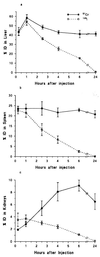Effects of colloidal resuscitation fluids on reticuloendothelial function and resistance to infection after hemorrhage
- PMID: 9665964
- PMCID: PMC95615
- DOI: 10.1128/CDLI.5.4.543-549.1998
Effects of colloidal resuscitation fluids on reticuloendothelial function and resistance to infection after hemorrhage
Abstract
The effects of three resuscitation fluids, hydroxyethyl starch (HES), Haemaccel, and fresh autologous blood, on reticuloendothelial system phagocytic and catabolic functions and resistance to infection after 40% hemorrhages in BALB/c mice were studied. The mice, anesthetized with isoflurane, were bled over a 10-min period, left hypovolemic for 30 min, and then resuscitated with their shed blood or the same volume of asanguineous fluid. Normothermia was maintained throughout the experiments. The uptake and catabolism of intravenously injected double-labelled sheep erythrocytes (51Cr-125I-SRBC) in liver and spleen were determined at 1 and 48 h after hemorrhage. No significant changes in the uptake or catabolism of SRBC in liver or spleen were found at 1 h after hemorrhage and resuscitation with any of the fluids. However, at 48 h a significant increase in liver uptake of SRBC was seen in animals resuscitated with either Haemaccel or HES compared to that in animals resuscitated with shed blood or in animals subjected to a sham operation. The increase in liver uptake was accompanied by a small decrease in spleen uptake in animals resuscitated with Haemaccel but not with HES. No great changes in catabolic activity were seen at 48 h, although activity levels tended to be higher in animals resuscitated with Haemaccel. Separate groups of animals were challenged by an intraperitoneal injection with live Escherichia coli at 1 or 48 h after hemorrhage and resuscitation. Sixty-four percent of the animals resuscitated with shed blood survived the challenge with E. coli at 1 h after hemorrhage, whereas only 10 and 0% survival was seen for animals resuscitated with Haemaccel and HES, respectively. At 48 h survival was 80% for shed-blood-resuscitated animals and 60 and 70% for Haemaccel- and HES-resuscitated animals, respectively.
Figures



Similar articles
-
Phagocytic reticuloendothelial function after hemorrhage and resuscitation: modulation by different fluids.Shock. 1997 Sep;8(3):219-24. doi: 10.1097/00024382-199709000-00011. Shock. 1997. PMID: 9377170
-
Reticuloendothelial function after hemorrhage and hypothermia.Shock. 1997 Apr;7(4):300-3. doi: 10.1097/00024382-199704000-00010. Shock. 1997. PMID: 9110417
-
Effect of resuscitation with hydroxyethyl starch and lactated Ringers on macrophage activity after hemorrhagic shock and sepsis.Shock. 1994 Aug;2(2):141-4. doi: 10.1097/00024382-199408000-00010. Shock. 1994. PMID: 7537166
-
Is there a place for crystalloids and colloids in remote damage control resuscitation?Shock. 2014 May;41 Suppl 1:47-50. doi: 10.1097/SHK.0000000000000117. Shock. 2014. PMID: 24430549 Review.
-
Crystalloid or colloid: does it matter?J Clin Anesth. 1989;1(6):464-71. doi: 10.1016/0952-8180(89)90013-5. J Clin Anesth. 1989. PMID: 2696509 Review.
Cited by
-
Systematic review of randomized clinical trials on the use of hydroxyethyl starch for fluid management in sepsis.BMC Emerg Med. 2008 Jan 24;8:1. doi: 10.1186/1471-227X-8-1. BMC Emerg Med. 2008. PMID: 18218122 Free PMC article.
References
-
- Aaseth J, Alexander J, Norseth T. Uptake of 51Cr-chromate by human erythrocytes. A role of glutathione. Acta Pharmacol Toxicol. 1982;50:310–315. - PubMed
-
- Altura B M. Hemorrhagic shock and reticuloendothelial system phagocytic function in pathogen-free animals. Circ Shock. 1974;1:295–300.
-
- Altura B M, Hershey S G. Sequential changes in reticuloendothelial system function after acute hemorrhage. Proc Soc Exp Biol Med. 1972;139:935–939. - PubMed
-
- Biozzi G, Stiffel C. The physiopathology of the reticuloendothelial cells of the liver and spleen. In: Popper H, Schaffner F, editors. Progress in liver disease. New York, N.Y: Grune and Stratton; 1965. pp. 166–187.
-
- Biozzi G, Halpern B N, Benacerraf B, Stiffel C. Phagocytic activity of the reticulo-endothelial system in experimental infections. In: Halpern B N, editor. Physiopathology of the reticuloendothelial system. Oxford, United Kingdom: Blackwell; 1957. pp. 204–225.
Publication types
MeSH terms
Substances
LinkOut - more resources
Full Text Sources
Medical

